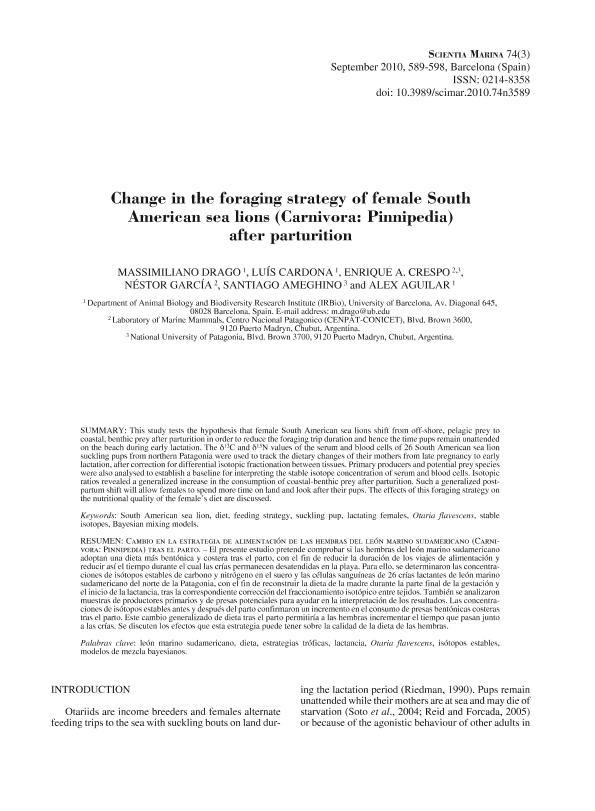Mostrar el registro sencillo del ítem
dc.contributor.author
Drago, Massimiliano
dc.contributor.author
Cardona, Luís
dc.contributor.author
Crespo, Enrique Alberto

dc.contributor.author
Garcia, Nestor Anibal

dc.contributor.author
Ameghino, Santiago Pedro

dc.contributor.author
Aguilar, Alex

dc.date.available
2020-01-10T19:54:45Z
dc.date.issued
2010-09
dc.identifier.citation
Drago, Massimiliano; Cardona, Luís; Crespo, Enrique Alberto; Garcia, Nestor Anibal; Ameghino, Santiago Pedro; et al.; Change in the foraging strategy of female South American sea lions (Carnivora: Pinnipedia) after parturition; Instituto de Ciencias del Mar Barcelona; Scientia Marina; 74; 3; 9-2010; 589-598
dc.identifier.issn
1886-8134
dc.identifier.uri
http://hdl.handle.net/11336/94373
dc.description.abstract
El presente estudio pretende comprobar si las hembras del león marino sudamericano adoptan una dieta más bentónica y costera tras el parto, con el fin de reducir la duración de los viajes de alimentación y reducir así el tiempo durante el cual las crías permanecen desatendidas en la playa. Para ello, se determinaron las concentraciones de isótopos estables de carbono y nitrógeno en el suero y las células sanguíneas de 26 crías lactantes de león marino sudamericano del norte de la Patagonia, con el fin de reconstruir la dieta de la madre durante la parte final de la gestación y el inicio de la lactancia, tras la correspondiente corrección del fraccionamiento isotópico entre tejidos. También se analizaron muestras de productores primarios y de presas potenciales para ayudar en la interpretación de los resultados. Las concentraciones de isótopos estables antes y después del parto confirmaron un incremento en el consumo de presas bentónicas costeras tras el parto. Este cambio generalizado de dieta tras el parto permitiría a las hembras incrementar el tiempo que pasan junto a las crías. Se discuten los efectos que esta estrategia puede tener sobre la calidad de la dieta de las hembras.
dc.description.abstract
This study tests the hypothesis that female South American sea lions shift from off-shore, pelagic prey to coastal, benthic prey after parturition in order to reduce the foraging trip duration and hence the time pups remain unattended on the beach during early lactation. The δ13C and δ15N values of the serum and blood cells of 26 South American sea lion suckling pups from northern Patagonia were used to track the dietary changes of their mothers from late pregnancy to early lactation, after correction for differential isotopic fractionation between tissues. Primary producers and potential prey species were also analysed to establish a baseline for interpreting the stable isotope concentration of serum and blood cells. Isotopic ratios revealed a generalized increase in the consumption of coastal-benthic prey after parturition. Such a generalized post-partum shift will allow females to spend more time on land and look after their pups. The effects of this foraging strategy on the nutritional quality of the female's diet are discussed.
dc.format
application/pdf
dc.language.iso
eng
dc.publisher
Instituto de Ciencias del Mar Barcelona

dc.rights
info:eu-repo/semantics/openAccess
dc.rights.uri
https://creativecommons.org/licenses/by-nc-sa/2.5/ar/
dc.subject
BAYESIAN MIXING MODELS
dc.subject
DIET
dc.subject
FEEDING STRATEGY
dc.subject
LACTATING FEMALES
dc.subject
OTARIA FLAVESCENS
dc.subject
SOUTH AMERICAN SEA LION
dc.subject
STABLE ISOTOPES
dc.subject
SUCKLING PUP
dc.subject.classification
Ecología

dc.subject.classification
Ciencias Biológicas

dc.subject.classification
CIENCIAS NATURALES Y EXACTAS

dc.title
Change in the foraging strategy of female South American sea lions (Carnivora: Pinnipedia) after parturition
dc.title
Cambio en la estrategia de alimentación de las hembras del león marino sudamericano (Carnivora: Pinnipedia) tras el parto
dc.type
info:eu-repo/semantics/article
dc.type
info:ar-repo/semantics/artículo
dc.type
info:eu-repo/semantics/publishedVersion
dc.date.updated
2019-09-20T15:11:43Z
dc.journal.volume
74
dc.journal.number
3
dc.journal.pagination
589-598
dc.journal.pais
España

dc.journal.ciudad
Barcelona
dc.description.fil
Fil: Drago, Massimiliano. Universidad de Barcelona; España
dc.description.fil
Fil: Cardona, Luís. Universidad de Barcelona; España
dc.description.fil
Fil: Crespo, Enrique Alberto. Consejo Nacional de Investigaciones Científicas y Técnicas. Centro Nacional Patagónico; Argentina. Universidad Nacional de la Patagonia "San Juan Bosco"; Argentina
dc.description.fil
Fil: Garcia, Nestor Anibal. Consejo Nacional de Investigaciones Científicas y Técnicas. Centro Nacional Patagónico; Argentina
dc.description.fil
Fil: Ameghino, Santiago Pedro. Universidad Nacional de la Patagonia "San Juan Bosco"; Argentina
dc.description.fil
Fil: Aguilar, Alex. Universidad de Barcelona; España
dc.journal.title
Scientia Marina

dc.relation.alternativeid
info:eu-repo/semantics/altIdentifier/doi/http://dx.doi.org/10.3989/scimar.2010.74n3589
dc.relation.alternativeid
info:eu-repo/semantics/altIdentifier/url/http://scientiamarina.revistas.csic.es/index.php/scientiamarina/article/view/1186
Archivos asociados
